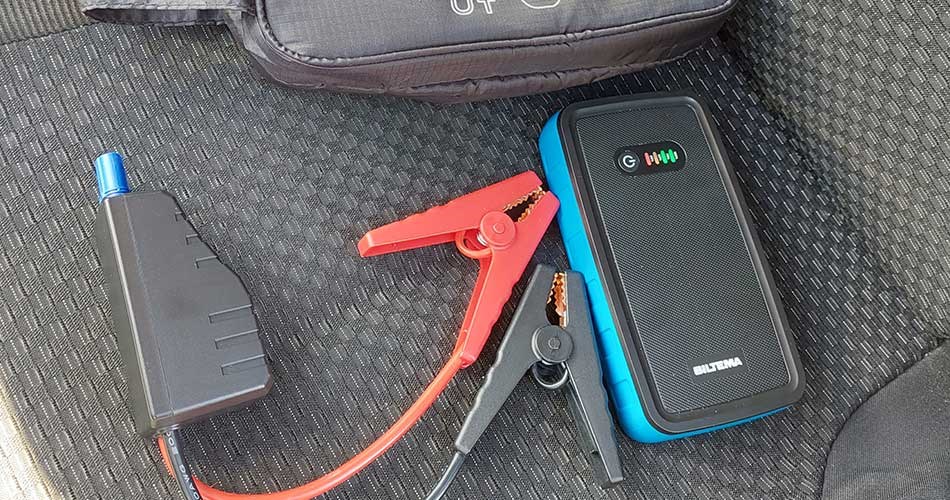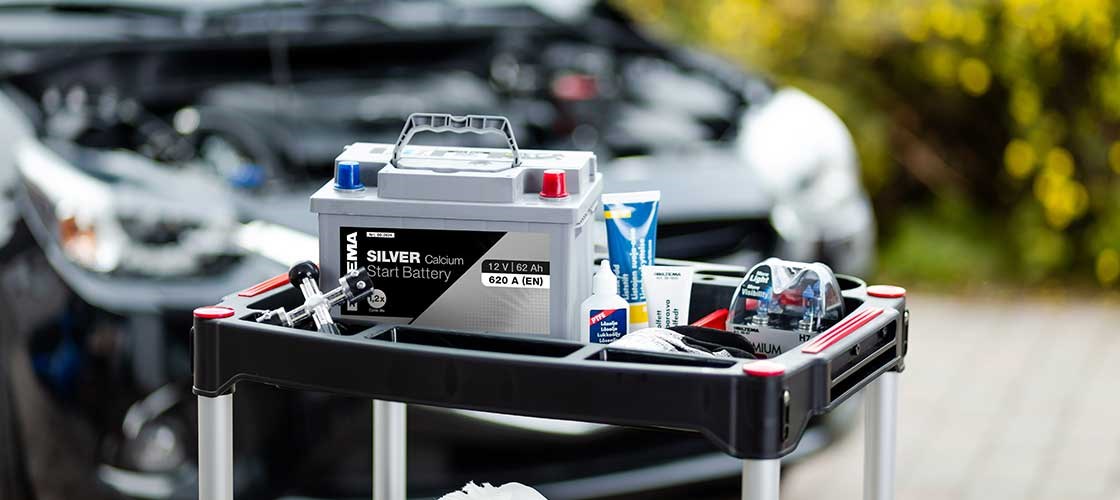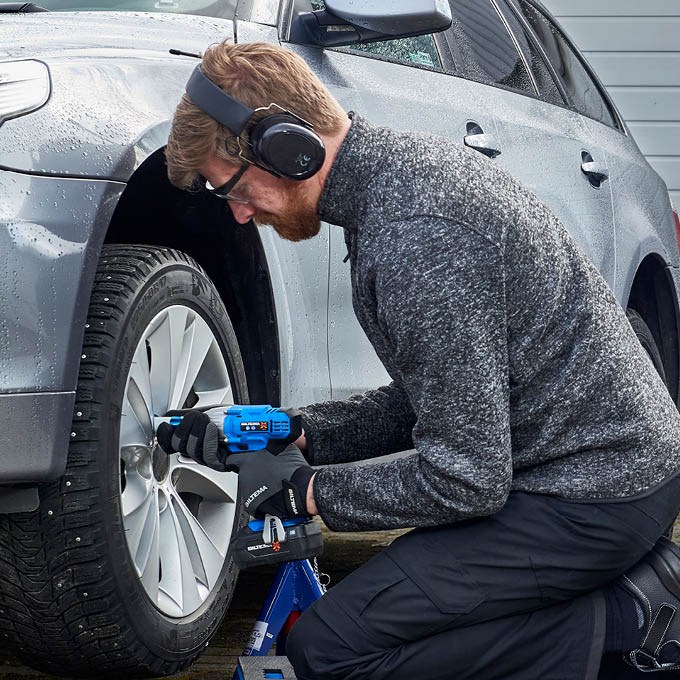Your Ultimate Car Battery Guide
You can get answers to all this and much more on this page. You can also take the fast road by searching with your licence plate number here and finding the right battery for your car. You can also type your licence plate number into the search bar at the top of the page.
What is a car battery?
A car battery is an essential component of your car. It is the power source that enables your car to start. The battery also provides power for the car’s accessories and equipment, which are connected to the electrical system. That includes everything from the car radio and GPS to the air conditioning system.
When you are driving and the car engine is running, the car battery is automatically charged by the alternator, but sometimes it may be necessary to charge or even replace the car battery. This may be the case if you find that your car has difficulty starting or if the various electrical functions do not work optimally. A well-functioning battery is therefore key to trouble-free driving. On this page, we will guide you through everything you need to know about car batteries.
Your guide to all types of car batteries
In our Car Battery Guide, we give you an overview of the different types of car batteries available. Later in the guide, we’ll also help you determine which car battery is right for your car.
- AMF batteries: AMF stands for Automotive Flooded, and AMF batteries are the most common type in the vast majority of cars. the battery is equipped with common standard terminals and it provides reliable power for both starting and operation. It is also known for its large capacity, long service life, and ability to withstand vibrations and bumps. However, this battery type is not maintenance-free. Both the electrolyte level and battery water must be checked regularly.
- EFB batteries: EFB stands for Enhanced Flooded Batteries and this type of battery is usually considered an upgraded version of AMF batteries. In fact, EFB batteries have twice as many charge cycles as ordinary batteries. The battery also typically has a longer service life because it is equipped with a different plate configuration. The performance is also somewhat better, as the battery charges faster.
- AGM batteries: AGM stands for Absorbent Glass Mat, and is an advanced car battery – ideal for cars with a stop-start function. AGM batteries are extra durable and resistant, and have a longer service life than standard batteries. The primary difference between AGM batteries and standard batteries is that AGM batteries are equipped with a fibreglass layer that absorbs liquid electrolytes. This makes it is safe to use since it does not leak acid. The battery is also distinguished by its efficiency, and it charges somewhat faster than ordinary batteries.
- Silver–calcium batteries and tin–calcium batteries: These batteries are reliable and maintenance-free. As the names indicate, they are based on silver–calcium or tin–calcium technology. They have a long service life and retain their charge longer than ordinary batteries. The batteries are also equipped with an indicator that displays the status of the battery. They also have a fan that reduces the risk of steam leakage, along with built-in flame protection.
- SMF batteries: SMF stands for Sealed Maintenance Free, and as the name indicates, SMF batteries do not require much maintenance. This battery is based on a so-called calcium technology, which gives the battery a long service life. The battery is also designed with special ventilation that minimises the risk of steam and acid leakage. In addition, the battery is flameproof.
Find all our different types of car batteries here.
Find all types of car batteries at Biltema
At Biltema you will find all types of car batteries in our extensive range – including AMF batteries, EFB batteries, AGM batteries, Silver calcium batteries, Tin calcium batteries and SMF batteries. Find all car batteries here.
Biltema offers a warranty of 3-4 years, depending on which car battery you choose. Look for the warranty badge, which is shown on the product page of each car battery. When you invest in a new battery for your car, it certainly feels reassuring to have a good warranty period. You can also be sure that we stand behind our products with great prices and high quality. If you need battery chargers or battery accessories, you will also find them in our range.
We know that it can be difficult to determine which car battery is right for your car, so we have compiled a guide to help you find the right car battery – no matter what car you have.

Which car battery fits my car?
Do you know what to look for when determining which battery is right for your car? This can be a challenging task, which is why we have compiled a guide containing the factors you should consider. It is important to find a battery that is compatible with your car to ensure optimal performance and, not least, to ensure that your car can start.
Battery type: There are several battery types, and it can be difficult to figure out whether you should choose an AGM battery, an AMF battery or some other model, because the different types are suitable for different cars, functions, and driving patterns. Fortunately, Biltema’s search by licence plate number solution can help. If you enter your licence plate number in the search field, you will find out which battery is right for your car. Search with licence plate number here.
Size: You should also make sure to choose a battery of the right size. They come in several different size groups. Therefore, check the size of your current battery and be sure to choose a new battery that matches the size group.
Cold cranking amps: The term refers to the amount of power your battery can provide when the temperature is cold. This is therefore also something you should pay attention to when choosing a car battery.
Battery capacity: Battery capacity is measured in amperes and refers to how much power the battery can deliver over a certain period of time. You should choose a battery with a capacity that matches your current battery.
Start-Stop function: Is your car equipped with a start-stop function? Then you must choose a battery that supports the function so that you get the most out of it.
If you are in doubt about which battery is right for your car, then it is a good idea to ask a professional. This will help to ensure that you invest in the right battery for your car.
Things that can cause a flat battery
Do you know that there are several different reasons your car battery becomes flat? We’ll guide you through some of the most common reasons you may want to be aware of to avoid a flat battery.
- Lights: Do you sometimes forget to turn off the lights on your car? This can result in a flat car battery. The lights drain the battery, and especially if you leave the car lights on for a long time, such as overnight.
- Cold temperatures: You might not think that the temperature makes a difference, but the winter cold can also contribute to your car battery becoming flat. The cold temperatures mean that your car has to work a bit harder than usual.
- Short trips: Do you often drive on short trips? The battery actually does not get enough time to charge properly over short distances, which may lead to a flat battery.
- Infrequent driving: If your car is mostly in the garage or driveway, the battery may become flat by slowly discharging.
- Dirty car battery: A dirty car battery can drain faster than a clean battery. Therefore, it is important that you remember to maintain it regularly.
- Service life: Unfortunately, a car battery does not last forever, and as the car gets older, it becomes harder for the battery to retain charge.
- Faulty alternator: If you drive around with a faulty alternator, the battery will not be charged when the car is in use.
- Wrong battery: Do you know which battery is right for your car? This is absolutely essential to know, because if you fit the wrong type, it can discharge quickly or even not work at all.
So, there are several different reasons why you may experience a flat car battery, which may need to be charged or replaced. And we discuss this more below.
Does your car battery need to be charged or replaced?
Do you find that your car has difficulty starting or that the internal electronics do not work optimally? This may be a sign that your battery either needs to be charged or replaced. Below we will guide you on what to do about your car battery in such situations.
However, it is important that you are aware that if your car cannot start or the air conditioning has stopped working, it can also be due to many other factors, and it does not necessarily mean the battery needs to be charged or replaced. If in doubt, you can contact a professional mechanic.
When to charge the battery
If your car battery has difficulty starting, but is otherwise in good condition, it may just need a manual charge. This can be caused by various factors, such as if the car lights have been on for a long time or if you often drive shorter distances.
When to replace the battery
If your car battery is old and you find that the battery repeatedly causes you problems, it may be a sign that the battery needs to be replaced instead of just charged. A car battery typically has a service life of 5-6 years, but the exact service life depends on how you maintain the battery and how much you use your car.
Guide: Charge your car battery yourself
If your car battery needs a charge, you can charge it yourself. A car battery is usually charged by the car’s alternator when the engine is running, but in some cases, it may be necessary to do a manual charge – for example, if it is cold outside.
There are two primary methods for charging your car battery yourself. You can either use jumper cables connected to another car battery, or you can use a charger. We’ll guide you through that here.

Jump starting
The method requires a set of jumper cables and another car that has a fully charged battery. It includes a few steps, which we go through here.
- Park the two cars close to each other, but make sure they are not in contact. Also make sure to turn off both cars.
- Connect one end of the red jumper cable to the positive (+) battery terminal on the flat battery. It is important that you know which terminals are which, otherwise there is a risk of short-circuiting.
- Connect the other end of the red jumper cable to the positive (+) battery terminal of the fully charged battery.
- Then connect the black cable to the negative (-) battery terminal of the fully charged battery.
- Connect the other end of the black cable to the car with the flat battery. There is usually a specific connector to which the cable must be connected.
- Start the car with the fully charged battery and leave it on for a few minutes before starting the car with the flat battery.
- After the car with the flat battery is started, it is time to remove the cables in a specific order. You must first remove the black cable from the car with the flat battery, and then remove the black cable from the other car.
- Next, remove the red cables in the same order as the black cables.
- Lastly, take a drive to recharge the battery. Preferably a trip of half an hour or longer if possible. This reduces the risk that you will need jump start your car the next time you try to start it.
- Afterwards, you can also connect the car to a charger to fully charge the battery.
Manual charging
A charger is a device that can charge your car battery, and the charging process follows a few different steps, which we’ll elaborate on below.
- Make sure your car is turned off before you start.
- Connect the red cable from the charger to the positive (+) battery terminal, and the black cable from the charger to the negative (-) battery terminal.
- Then turn on the charger and let the battery charge. The exact charging time may vary from car to car and charger to charger.
- When your battery is fully charged, there is usually a light that turns on or some other indication.
- Once the car is charged, it’s time to turn off the charger and disconnect the cables.
- Next, try to start the car and test the battery. If the car does not start, it may be that the battery is defective and therefore needs to be replaced.
If you are in doubt about how to best charge your car, check the owner manual or contact a professional for advice on the process.
Guide: How to replace your car battery
Does your car battery need a to be replaced? We have compiled a guide on how to replace your car battery. It may seem like a difficult task, but in fact, you can do it yourself if you have the courage. If you are in doubt about the task, then it is of course a good idea to either consult a professional or let them replace the battery.
- The first thing you should ensure is that you have the correct model ready. It can be difficult to find out which car battery fits your car, but you can use our licence plate number solution here.
- First of all, you should make sure that the car is turned off and the key removed. You should also wear gloves and safety glasses, because battery acid can be harmful.
- Next, open the bonnet.
- After that, start by loosening the cables. Start with the black cable – i.e. the negative terminal (-). Then remove the red cable, which is the positive terminal (+).
- Once both cables are disconnected, you can detach the battery and remove it from the car. Make sure to check how the battery is oriented and mounted for when you install the new car battery. If necessary, take a photo.
- Before you start installing the battery, the terminals must be cleaned – preferably with a battery terminal brush. And finally, grease them with battery terminal grease.
- Now it’s time to insert the new battery – with the same orientation as the old battery.
- Afterwards, reconnect the cables. First the positive cable (+) and then the negative (-).
- Lastly, try to start the car. If it starts, then you have succeeded with the task and replaced the battery correctly. However, if the car does not start, you should check the cables again and make sure that they are connected correctly.
After inserting the new car battery, you must dispose of the old battery appropriately, because it contains harmful substances. Contact a vehicle workshop to hand in the old battery. You can also hand it in at your local recycling centre.
Our guide to replacing a car battery helps you get the job done yourself at home in the garage or driveway. And remember – if you are in doubt about how to proceed, it is smart to let a professional handle the task to ensure that it is done correctly.
Your guide to maintaining your car battery
Proper maintenance of a car battery can help ensure that it does not become flat. If you do not regularly maintain it, the battery may drain faster, and this may shorten its service life. There are several ways you can maintain your car battery, and we have compiled a guide on what you can do.
- Check the battery regularly: You should check the battery regularly – a few times a year. You can also get a workshop to check it if you don’t know how.
- Avoid discharging the battery completely: If possible, do not allow the battery to completely discharge, as this can shorten the service life. If the battery becomes flat, the electrical plates oxidize or rust, and this causes the battery to permanently lose its capacity.
- Drive regularly: If you want to maintain your car battery, you should make sure to drive regularly. If your car stands stationary in the garage for a long period of time, the battery may lose its effectiveness.
- Clean the battery: A car battery can get dirty over time, which is why it should be cleaned from time to time. Dirt can easily accumulate, which can affect the service life of the battery.
- Check the battery water level: It may sound strange, but if you have a conventional battery, you should check the battery water level from time to time. And if the water level is low, you should top up with distilled water.
- Proper storage: If you plan for your car to be stationary for an extended period of time, it can be a good idea to remove the battery completely and store it in a safe place. However, you must connect the battery to a maintenance charger during storage.
If you follow the various maintenance tips in our car battery guide, you can keep your battery in good condition – which will also help extend its service life.




